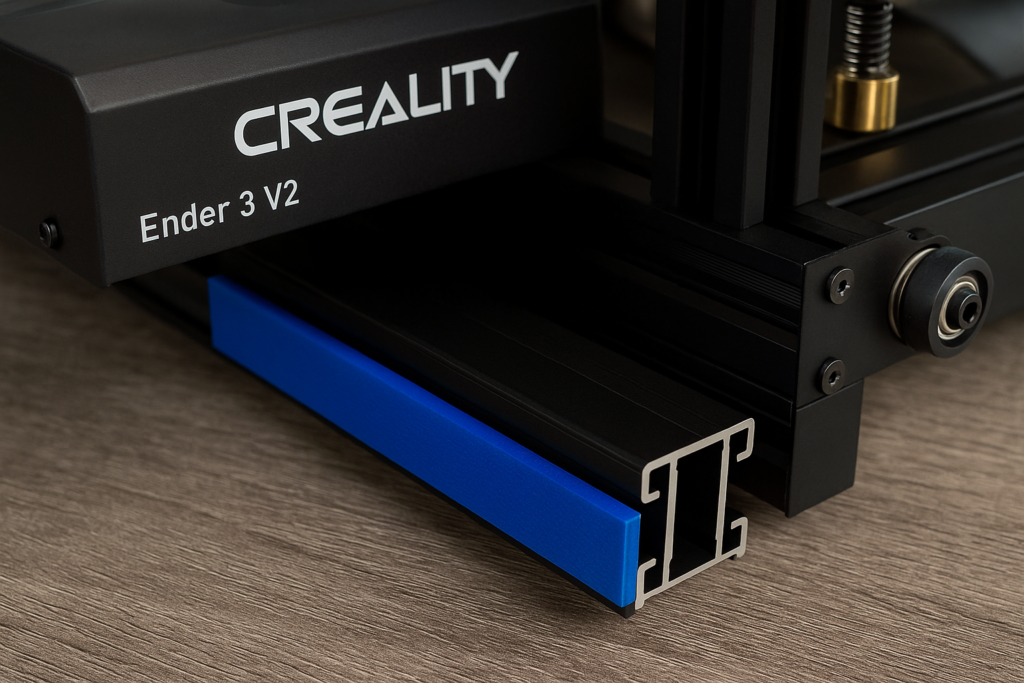The Ender 3 V2 is one of the most popular 3D printers on the market. Known for its balance of quality and affordability, it’s a favourite among beginners and pros alike. But even great machines have room for upgrades. One easy, effective modification is the 3D print Ender 3 V2 slot cover. While it may seem like a small addition, a slot cover provides several real benefits—from keeping dust out of your aluminium extrusion rails to improving cable organisation and overall aesthetics. If you’re printing with this model, or planning to, here’s why you should consider this simple yet valuable add-on.

What Is a Slot Cover on the Ender 3 V2?
The Ender 3 V2 has an open aluminium extrusion frame. These slots, also called T-slots or V-slot channels, are part of the design. They provide structural strength and allow you to mount accessories or route wires.
However, those same channels collect:
- Dust
- Debris
- Loose filament
- Oils from your hands
That’s where a slot cover comes in. It’s a custom-fit band or supplement that photos straight into the edge’s slit to cover and defend it. Some operators even design shelters that double as cable leaders or label containers.
Why You Should Use a Slot Cover
Slot covers may seem like an enhancing feature, but they serve applied purposes:
1. Dirt Defence
Dirt buildup inside slots can affect accessories like device supports or touch screens that straddle the edge.
2. Chain Organisation
Some published slot shelters include stations or clips for well-ordered cable steering. This keeps ropes safe and prevents them from knotting.
3. Better Arrival
An overview look adds refinement to your build. Covers come in different colours so that you can match or contrast with your copier.
4. Safety
Covers can help avoid cuts or scratches from sharp metal edges during cleaning or maintenance.
5. Customisation
You can label axes, embed logos, or even print LED strips directly into the slot cover design for personal flair.
Printing Your Own Slot Cover
One of the best things about owning a 3D printer is being able to customise it with your own prints. A 3D print Ender 3 V2 slot cover is a quick and satisfying weekend project.
Here’s what you’ll need:
- PLA or PETG filament (PLA is fine unless you’re in a hot workshop)
- A digital calliper or ruler to measure your slots (usually ~6mm wide, 10mm deep)
- A reliable STL file (many are free on file-sharing platforms)
- Your Ender 3 V2 is tuned and ready for clean dimensional accuracy
Typical print time: ~30 minutes to 2 hours, depending on length and design.
Design Tips for Better Fit
If you’re designing your own slot cover, keep these tips in mind:
- Tolerances matter: Aim for a snug fit without forcing the piece in. 0.2 mm clearance usually works well.
- Segmented designs: Print in smaller sections if you want easy removal later, or have long rails.
- Flexible materials: TPU can be used for an ultra-snug press fit with easy removal.
- Rounded corners: Prevent snapping or over-tight friction by softening edges.
If you’re downloading a pre-made STL, double-check reviews or user comments to make sure it fits the Ender 3 V2 specifically—not all extrusion profiles are the same.
Other Creative Uses for Slot Covers
Beyond simple dust protection, you can use your slot cover as a multi-functional upgrade:
- Cable clips: Add hooks or zip tie slots into the print
- Sensor mounts: Built-in holders for filament run-out or BLTouch sensors
- Lighting tracks: Create a channel to snap in LED strips
- Tool holders: Include small inserts for Allen keys or nozzles
- QR codes: Embed a small label with a QR code for printer instructions or maintenance logs
It’s not just about covering—it’s about turning unused space into useful space.
Slot Cover vs. Commercial Rail Inserts
You may have seen commercial slot covers or T-slot rail inserts made of rubber or plastic. While those work fine, 3D printing your own gives you:
- Exact length and fit
- Personal style choices
- Lower cost
- Function beyond simple coverage
Plus, why buy what you can create yourself in just a few hours?
Common Problems and Fixes
Like any print, slot covers can come with challenges. Here’s how to troubleshoot:
Problem: The Slot cover is too tight
Fix: Reduce the width slightly in your slicer, or sand edges gently.
Problem: The Slot cover falls out
Fix: Increase print width slightly or use TPU filament for flexibility and grip.
Problem: Warping or lifting
Fix: Use a brim, slow down first layers, and ensure the bed is level and hot enough for your filament.
Problem: Slots are not perfectly clean
Fix: Use a cotton swab, compressed air, or a plastic scraper to clean slots before inserting covers.
READ MORE – VXLabs 3D Print Leak: What Happened and What It Means for the 3D Printing Community
FAQs:
Q: What material is best for printing slot covers?
A: PLA is fine for general use. PETG adds heat resistance, and TPU gives a flexible, snug fit. Avoid ABS unless needed, as it can warp.
Q: Are there pre-made designs available online?
A: Yes. Many STL files are available. Look for ones labelled specifically for Ender 3 V2 to ensure compatibility.
Q: How do I remove a slot cover later?
A: Use a plastic pry tool or print segmented covers that pull out more easily. Avoid metal tools to protect the frame.
Q: Can I print colored covers to match my build?
A: Absolutely. Slot covers are great for adding colour themes to your setup. Use filament in custom shades or dual-colour transitions.
Q: Will slot covers interfere with printer upgrades?
A: Not if designed correctly. In fact, you can design your covers to include space or clips for wires, sensors, or brackets.
Conclusion:
A 3d print Ender 3 V2 slot cover may seem like a small addition, but it’s one of the most satisfying upgrades you can make. It’s quick, functional, and allows you to leave your personal mark on the printer. Whether you’re after cleaner looks, safer cables, or better dust control, this is a smart print for any Ender 3 owner. And the best part? You get to design it your way.
So go ahead, fire up your slicer, load your filament, and print something that improves your printer while showing off your creativity. Small prints. Big impact.

